Risk Assessment for Organisational Change at FitLife Simulation
VerifiedAdded on 2023/01/06
|8
|1106
|30
Report
AI Summary
This report presents a risk assessment for FitLife Simulation Company, focusing on potential barriers to organizational change. The analysis identifies and evaluates various risk factors, including psychological, cultural, perceptual, technological, and socio-religious barriers. The report details specific measures to mitigate these risks, such as improving communication, fostering a positive work environment, promoting cultural understanding, providing adequate training, and integrating diverse perspectives. The conclusion emphasizes the significance of risk assessment in effectively managing the challenges associated with change and ensuring a smoother transition within the organization. The report provides recommendations for overcoming the identified barriers and facilitating successful change management within the company.
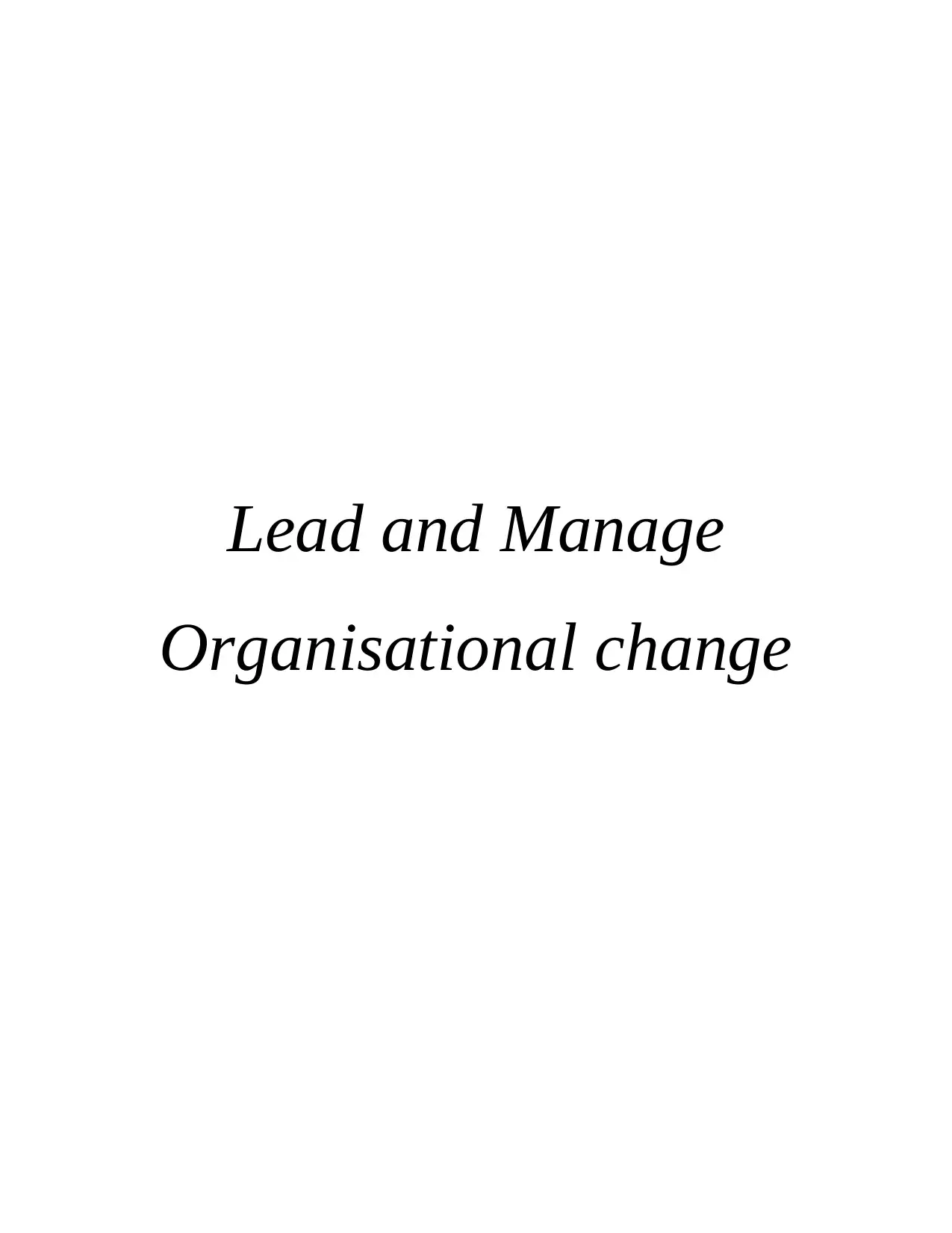
Lead and Manage
Organisational change
Organisational change
Paraphrase This Document
Need a fresh take? Get an instant paraphrase of this document with our AI Paraphraser

Table of Contents
TASK 2............................................................................................................................................1
2.2 Undertaking risk analysis for addressing potential barriers to change..................................1
REFERENCES................................................................................................................................5
TASK 2............................................................................................................................................1
2.2 Undertaking risk analysis for addressing potential barriers to change..................................1
REFERENCES................................................................................................................................5
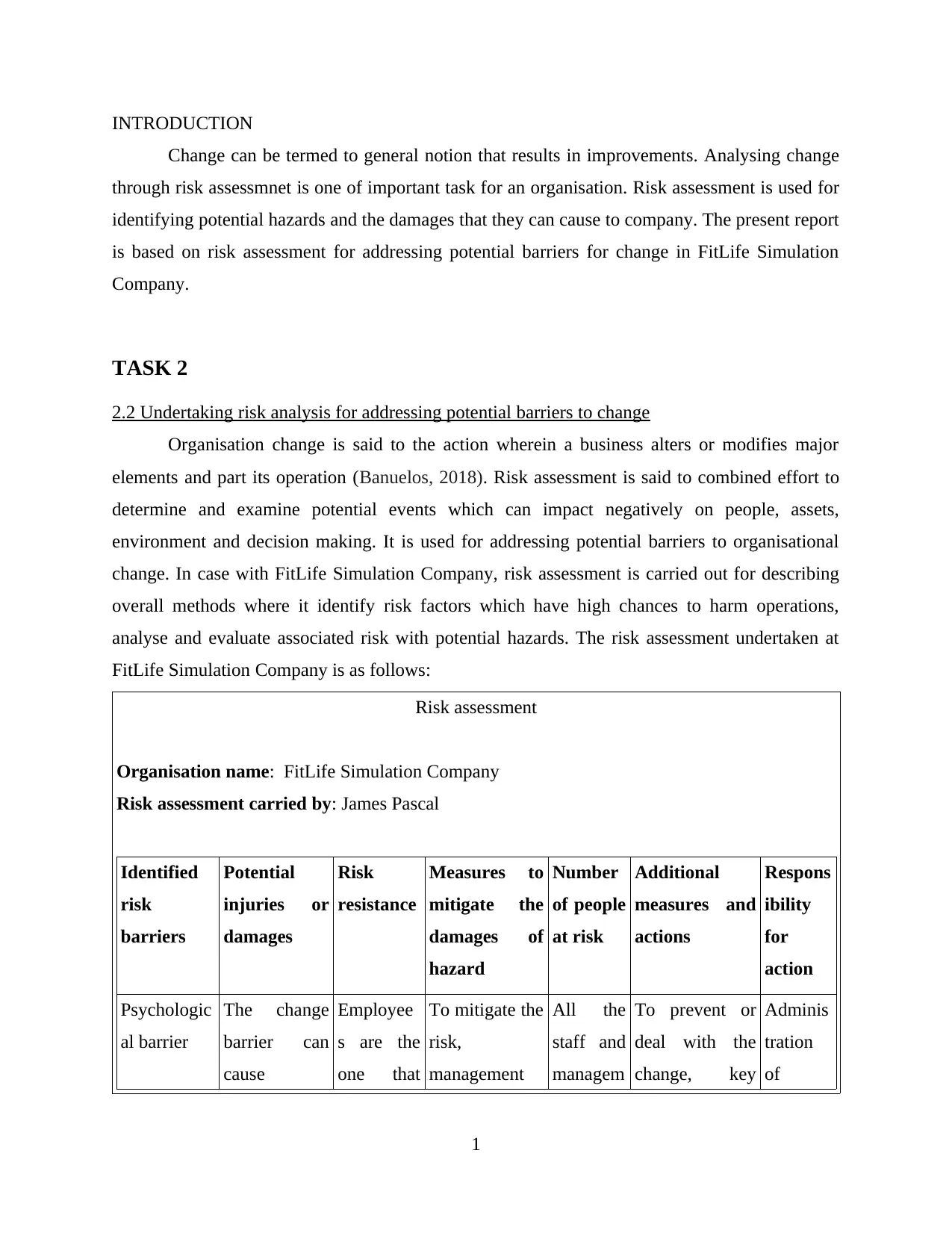
INTRODUCTION
Change can be termed to general notion that results in improvements. Analysing change
through risk assessmnet is one of important task for an organisation. Risk assessment is used for
identifying potential hazards and the damages that they can cause to company. The present report
is based on risk assessment for addressing potential barriers for change in FitLife Simulation
Company.
TASK 2
2.2 Undertaking risk analysis for addressing potential barriers to change
Organisation change is said to the action wherein a business alters or modifies major
elements and part its operation (Banuelos, 2018). Risk assessment is said to combined effort to
determine and examine potential events which can impact negatively on people, assets,
environment and decision making. It is used for addressing potential barriers to organisational
change. In case with FitLife Simulation Company, risk assessment is carried out for describing
overall methods where it identify risk factors which have high chances to harm operations,
analyse and evaluate associated risk with potential hazards. The risk assessment undertaken at
FitLife Simulation Company is as follows:
Risk assessment
Organisation name: FitLife Simulation Company
Risk assessment carried by: James Pascal
Identified
risk
barriers
Potential
injuries or
damages
Risk
resistance
Measures to
mitigate the
damages of
hazard
Number
of people
at risk
Additional
measures and
actions
Respons
ibility
for
action
Psychologic
al barrier
The change
barrier can
cause
Employee
s are the
one that
To mitigate the
risk,
management
All the
staff and
managem
To prevent or
deal with the
change, key
Adminis
tration
of
1
Change can be termed to general notion that results in improvements. Analysing change
through risk assessmnet is one of important task for an organisation. Risk assessment is used for
identifying potential hazards and the damages that they can cause to company. The present report
is based on risk assessment for addressing potential barriers for change in FitLife Simulation
Company.
TASK 2
2.2 Undertaking risk analysis for addressing potential barriers to change
Organisation change is said to the action wherein a business alters or modifies major
elements and part its operation (Banuelos, 2018). Risk assessment is said to combined effort to
determine and examine potential events which can impact negatively on people, assets,
environment and decision making. It is used for addressing potential barriers to organisational
change. In case with FitLife Simulation Company, risk assessment is carried out for describing
overall methods where it identify risk factors which have high chances to harm operations,
analyse and evaluate associated risk with potential hazards. The risk assessment undertaken at
FitLife Simulation Company is as follows:
Risk assessment
Organisation name: FitLife Simulation Company
Risk assessment carried by: James Pascal
Identified
risk
barriers
Potential
injuries or
damages
Risk
resistance
Measures to
mitigate the
damages of
hazard
Number
of people
at risk
Additional
measures and
actions
Respons
ibility
for
action
Psychologic
al barrier
The change
barrier can
cause
Employee
s are the
one that
To mitigate the
risk,
management
All the
staff and
managem
To prevent or
deal with the
change, key
Adminis
tration
of
1
⊘ This is a preview!⊘
Do you want full access?
Subscribe today to unlock all pages.

Trusted by 1+ million students worldwide
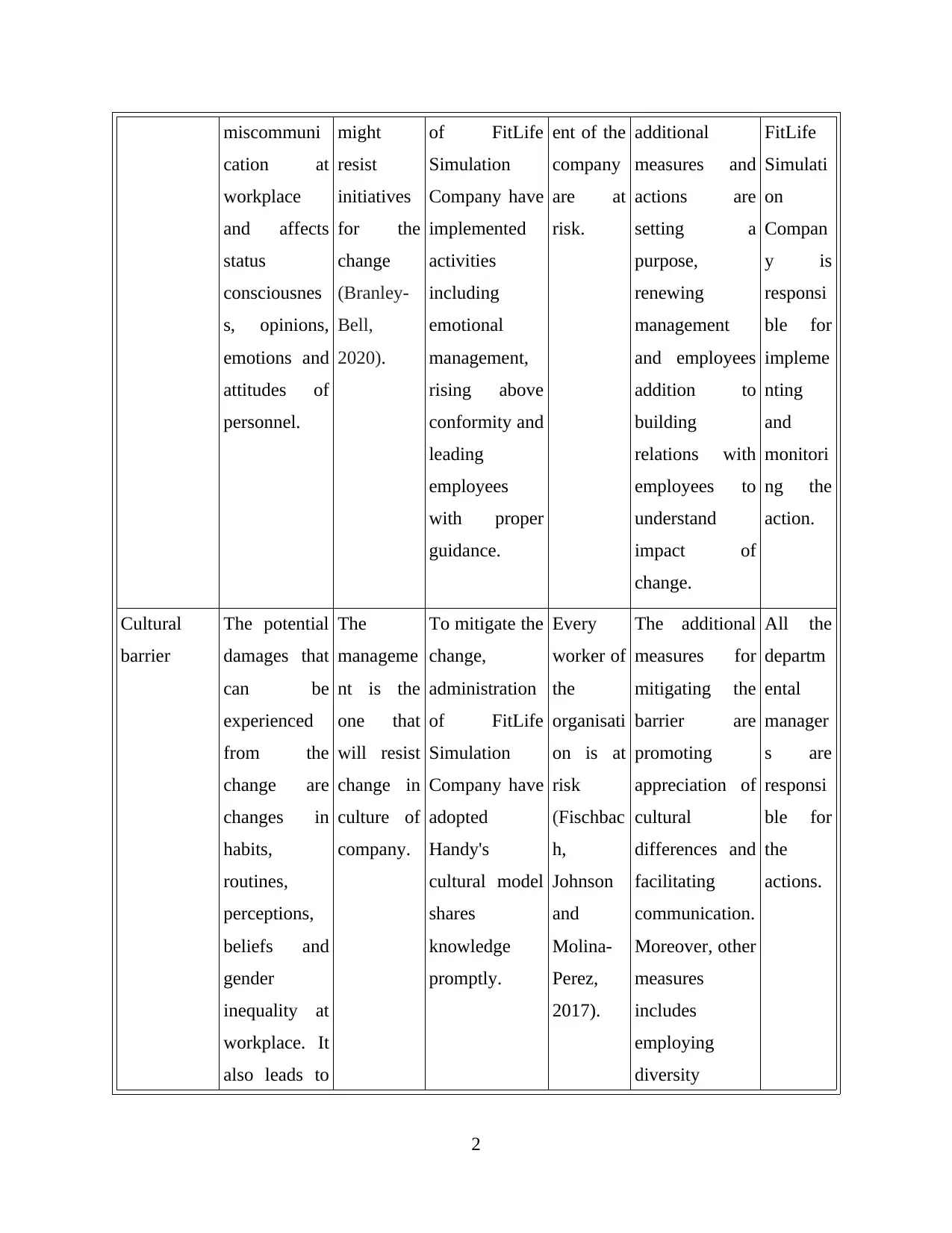
miscommuni
cation at
workplace
and affects
status
consciousnes
s, opinions,
emotions and
attitudes of
personnel.
might
resist
initiatives
for the
change
(Branley-
Bell,
2020).
of FitLife
Simulation
Company have
implemented
activities
including
emotional
management,
rising above
conformity and
leading
employees
with proper
guidance.
ent of the
company
are at
risk.
additional
measures and
actions are
setting a
purpose,
renewing
management
and employees
addition to
building
relations with
employees to
understand
impact of
change.
FitLife
Simulati
on
Compan
y is
responsi
ble for
impleme
nting
and
monitori
ng the
action.
Cultural
barrier
The potential
damages that
can be
experienced
from the
change are
changes in
habits,
routines,
perceptions,
beliefs and
gender
inequality at
workplace. It
also leads to
The
manageme
nt is the
one that
will resist
change in
culture of
company.
To mitigate the
change,
administration
of FitLife
Simulation
Company have
adopted
Handy's
cultural model
shares
knowledge
promptly.
Every
worker of
the
organisati
on is at
risk
(Fischbac
h,
Johnson
and
Molina-
Perez,
2017).
The additional
measures for
mitigating the
barrier are
promoting
appreciation of
cultural
differences and
facilitating
communication.
Moreover, other
measures
includes
employing
diversity
All the
departm
ental
manager
s are
responsi
ble for
the
actions.
2
cation at
workplace
and affects
status
consciousnes
s, opinions,
emotions and
attitudes of
personnel.
might
resist
initiatives
for the
change
(Branley-
Bell,
2020).
of FitLife
Simulation
Company have
implemented
activities
including
emotional
management,
rising above
conformity and
leading
employees
with proper
guidance.
ent of the
company
are at
risk.
additional
measures and
actions are
setting a
purpose,
renewing
management
and employees
addition to
building
relations with
employees to
understand
impact of
change.
FitLife
Simulati
on
Compan
y is
responsi
ble for
impleme
nting
and
monitori
ng the
action.
Cultural
barrier
The potential
damages that
can be
experienced
from the
change are
changes in
habits,
routines,
perceptions,
beliefs and
gender
inequality at
workplace. It
also leads to
The
manageme
nt is the
one that
will resist
change in
culture of
company.
To mitigate the
change,
administration
of FitLife
Simulation
Company have
adopted
Handy's
cultural model
shares
knowledge
promptly.
Every
worker of
the
organisati
on is at
risk
(Fischbac
h,
Johnson
and
Molina-
Perez,
2017).
The additional
measures for
mitigating the
barrier are
promoting
appreciation of
cultural
differences and
facilitating
communication.
Moreover, other
measures
includes
employing
diversity
All the
departm
ental
manager
s are
responsi
ble for
the
actions.
2
Paraphrase This Document
Need a fresh take? Get an instant paraphrase of this document with our AI Paraphraser

dysfunctional
adaptation
behaviours
and
unresolved
conflicts.
training is best
for managing
the change
barrier.
Perception
barrier
It have high
chances to
damage what
is perceived
by employees
about same
things and
their
knowledge
for effective
change
management.
Entire
workforce
of FitLife
Simulation
Company
can resist
the
change.
Through
examining and
correcting
assumptions,
seeking clarity
and
challenging
assumptions
are some of
measures that
are taken for
mitigating the
change barrier.
All
people
that are
involved
in
working
at FitLife
Simulatio
n
Company
.
The additional
measures
required for
preventing the
barrier is
starting
conversation
with positive
notes and
understanding
perceptions of
others for
devising further
activities.
Manage
ment of
FitLife
Simulati
on
Compan
y is
responsi
ble for
the
actions.
Technologic
al
advancemen
t
It speed-up
workflows as
well as
provide
indispensable
systems to
organise
information,
creates false
knowledge
All the
employees
that work
in
technolog
y
departmen
t resist
change
(Lewis
To prevent the
change barrier,
technological
manager have
implemented
innovate tools
that employees
are aware of,
easy to use
digital
The
whole
technolog
ical unit.
Additional
measures that
are required for
preventing the
change barrier
is proper
training about
technological
advancement
and their uses
Technol
ogical
manager
is
responsi
ble for
the
action.
3
adaptation
behaviours
and
unresolved
conflicts.
training is best
for managing
the change
barrier.
Perception
barrier
It have high
chances to
damage what
is perceived
by employees
about same
things and
their
knowledge
for effective
change
management.
Entire
workforce
of FitLife
Simulation
Company
can resist
the
change.
Through
examining and
correcting
assumptions,
seeking clarity
and
challenging
assumptions
are some of
measures that
are taken for
mitigating the
change barrier.
All
people
that are
involved
in
working
at FitLife
Simulatio
n
Company
.
The additional
measures
required for
preventing the
barrier is
starting
conversation
with positive
notes and
understanding
perceptions of
others for
devising further
activities.
Manage
ment of
FitLife
Simulati
on
Compan
y is
responsi
ble for
the
actions.
Technologic
al
advancemen
t
It speed-up
workflows as
well as
provide
indispensable
systems to
organise
information,
creates false
knowledge
All the
employees
that work
in
technolog
y
departmen
t resist
change
(Lewis
To prevent the
change barrier,
technological
manager have
implemented
innovate tools
that employees
are aware of,
easy to use
digital
The
whole
technolog
ical unit.
Additional
measures that
are required for
preventing the
change barrier
is proper
training about
technological
advancement
and their uses
Technol
ogical
manager
is
responsi
ble for
the
action.
3
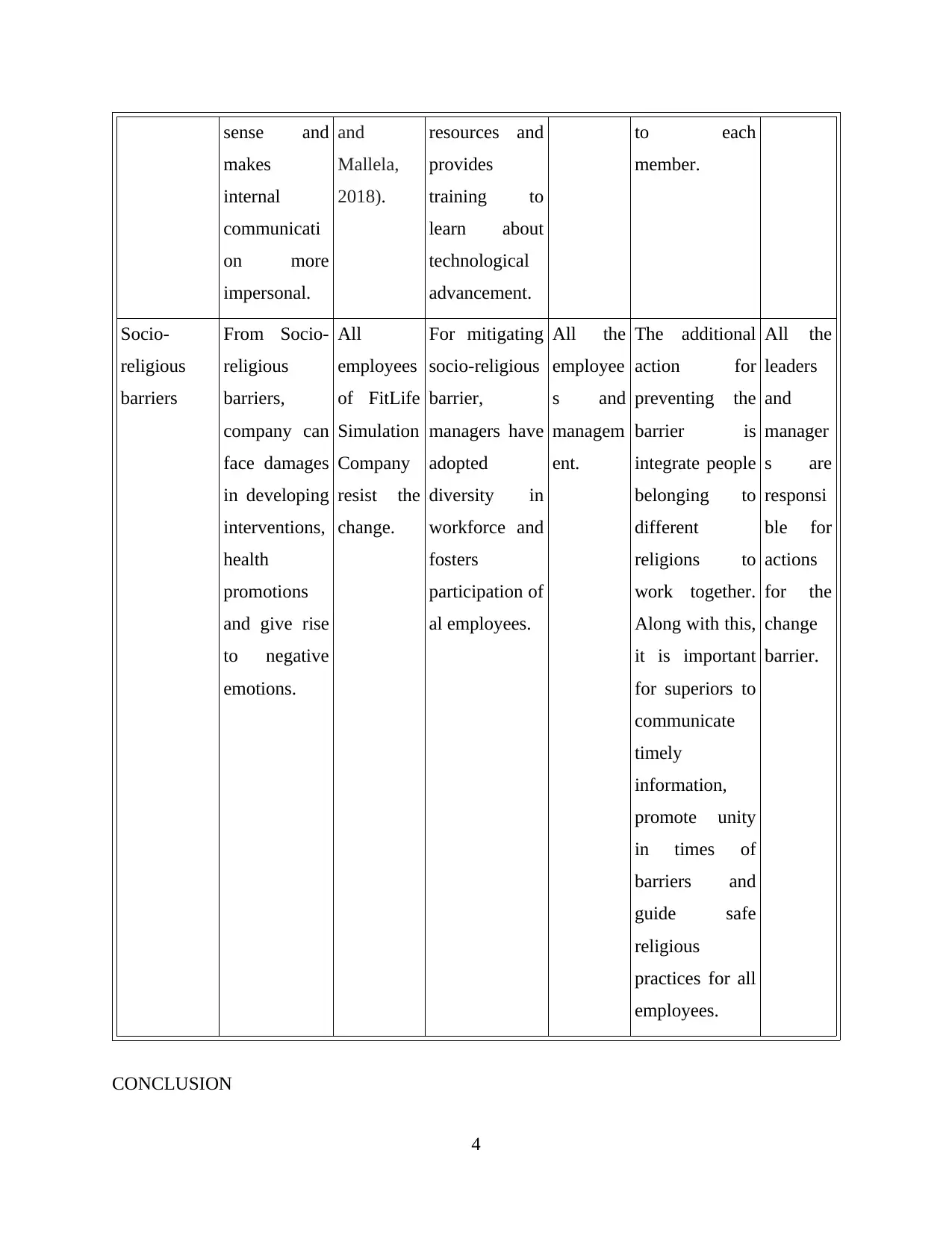
sense and
makes
internal
communicati
on more
impersonal.
and
Mallela,
2018).
resources and
provides
training to
learn about
technological
advancement.
to each
member.
Socio-
religious
barriers
From Socio-
religious
barriers,
company can
face damages
in developing
interventions,
health
promotions
and give rise
to negative
emotions.
All
employees
of FitLife
Simulation
Company
resist the
change.
For mitigating
socio-religious
barrier,
managers have
adopted
diversity in
workforce and
fosters
participation of
al employees.
All the
employee
s and
managem
ent.
The additional
action for
preventing the
barrier is
integrate people
belonging to
different
religions to
work together.
Along with this,
it is important
for superiors to
communicate
timely
information,
promote unity
in times of
barriers and
guide safe
religious
practices for all
employees.
All the
leaders
and
manager
s are
responsi
ble for
actions
for the
change
barrier.
CONCLUSION
4
makes
internal
communicati
on more
impersonal.
and
Mallela,
2018).
resources and
provides
training to
learn about
technological
advancement.
to each
member.
Socio-
religious
barriers
From Socio-
religious
barriers,
company can
face damages
in developing
interventions,
health
promotions
and give rise
to negative
emotions.
All
employees
of FitLife
Simulation
Company
resist the
change.
For mitigating
socio-religious
barrier,
managers have
adopted
diversity in
workforce and
fosters
participation of
al employees.
All the
employee
s and
managem
ent.
The additional
action for
preventing the
barrier is
integrate people
belonging to
different
religions to
work together.
Along with this,
it is important
for superiors to
communicate
timely
information,
promote unity
in times of
barriers and
guide safe
religious
practices for all
employees.
All the
leaders
and
manager
s are
responsi
ble for
actions
for the
change
barrier.
CONCLUSION
4
⊘ This is a preview!⊘
Do you want full access?
Subscribe today to unlock all pages.

Trusted by 1+ million students worldwide
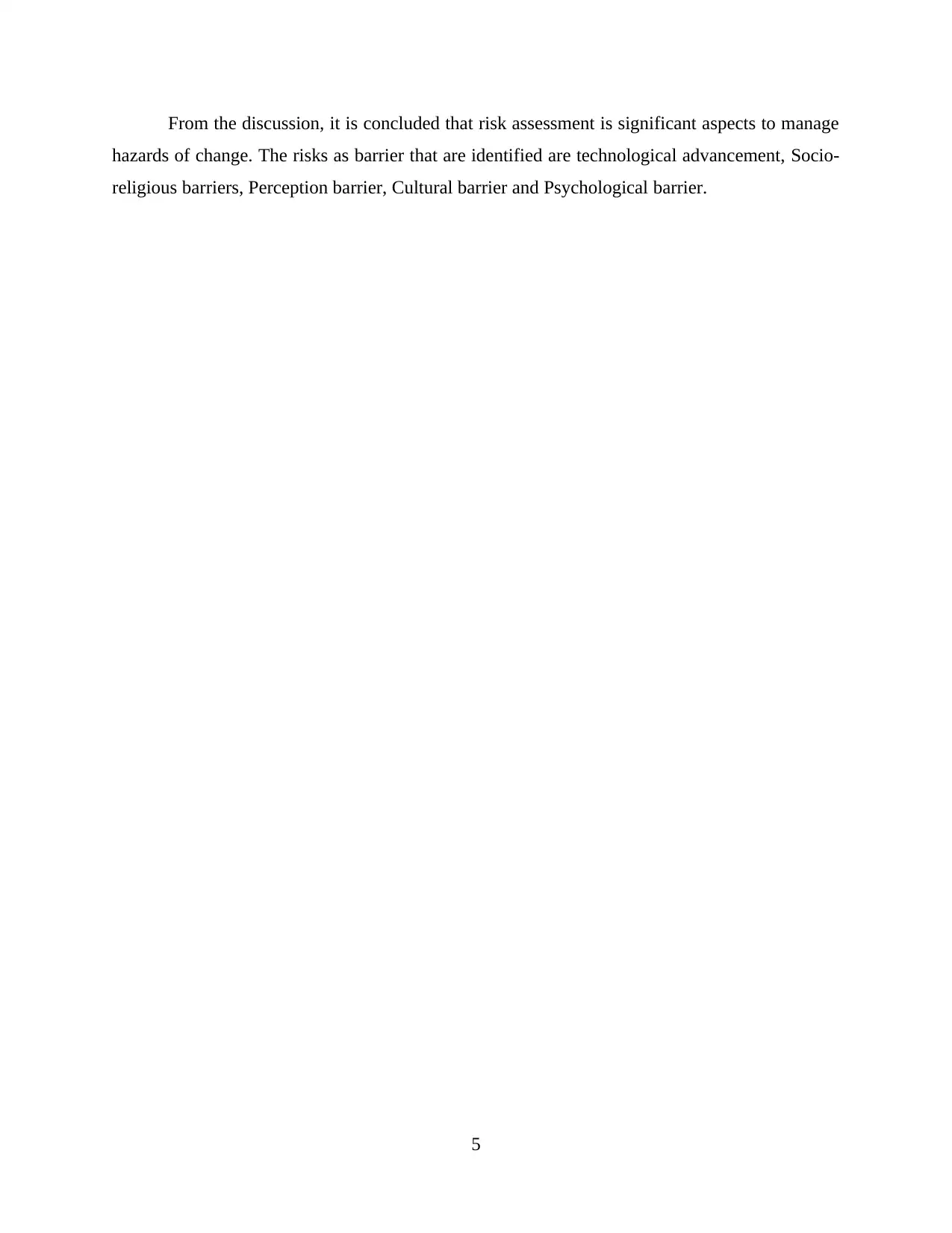
From the discussion, it is concluded that risk assessment is significant aspects to manage
hazards of change. The risks as barrier that are identified are technological advancement, Socio-
religious barriers, Perception barrier, Cultural barrier and Psychological barrier.
5
hazards of change. The risks as barrier that are identified are technological advancement, Socio-
religious barriers, Perception barrier, Cultural barrier and Psychological barrier.
5
Paraphrase This Document
Need a fresh take? Get an instant paraphrase of this document with our AI Paraphraser
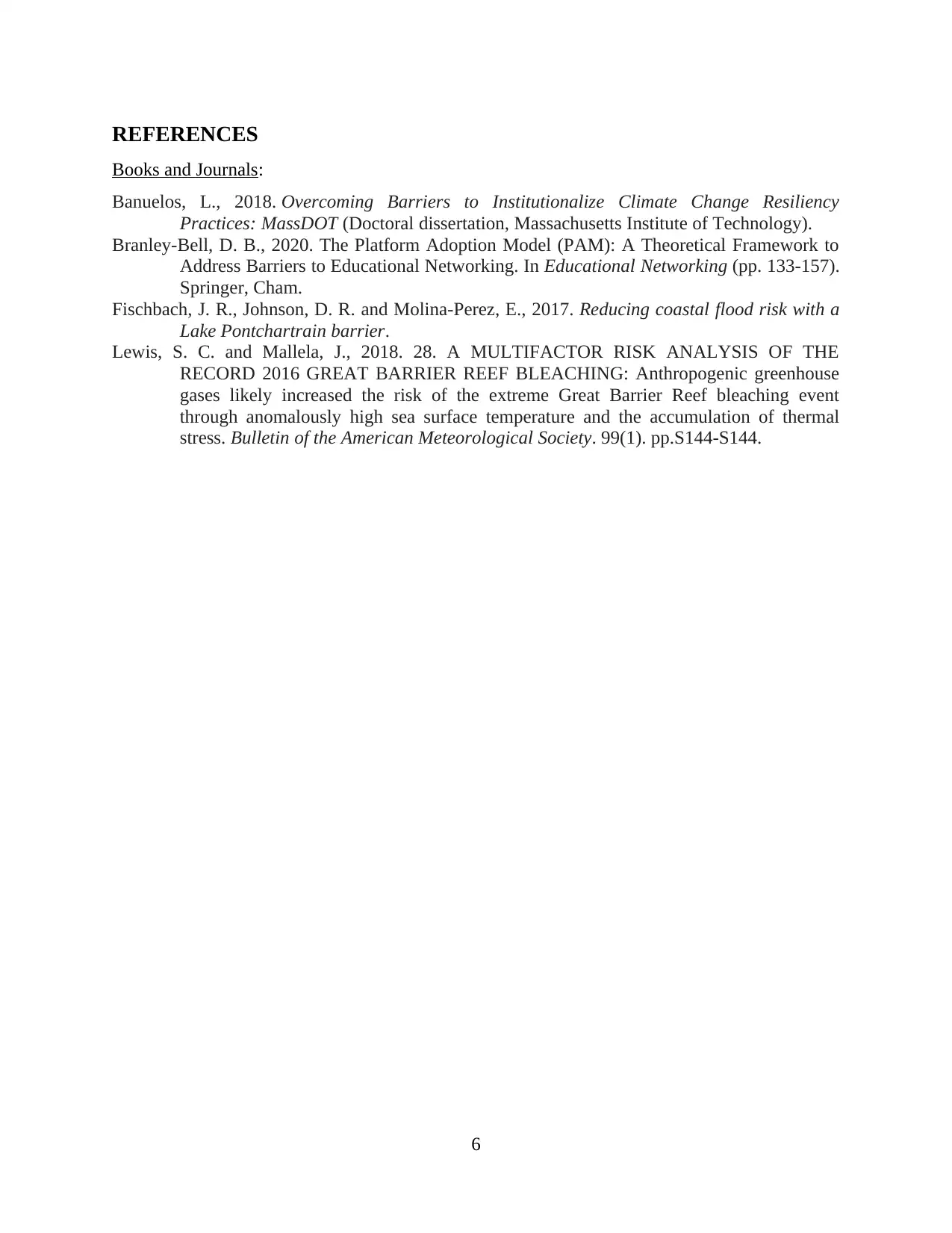
REFERENCES
Books and Journals:
Banuelos, L., 2018. Overcoming Barriers to Institutionalize Climate Change Resiliency
Practices: MassDOT (Doctoral dissertation, Massachusetts Institute of Technology).
Branley-Bell, D. B., 2020. The Platform Adoption Model (PAM): A Theoretical Framework to
Address Barriers to Educational Networking. In Educational Networking (pp. 133-157).
Springer, Cham.
Fischbach, J. R., Johnson, D. R. and Molina-Perez, E., 2017. Reducing coastal flood risk with a
Lake Pontchartrain barrier.
Lewis, S. C. and Mallela, J., 2018. 28. A MULTIFACTOR RISK ANALYSIS OF THE
RECORD 2016 GREAT BARRIER REEF BLEACHING: Anthropogenic greenhouse
gases likely increased the risk of the extreme Great Barrier Reef bleaching event
through anomalously high sea surface temperature and the accumulation of thermal
stress. Bulletin of the American Meteorological Society. 99(1). pp.S144-S144.
6
Books and Journals:
Banuelos, L., 2018. Overcoming Barriers to Institutionalize Climate Change Resiliency
Practices: MassDOT (Doctoral dissertation, Massachusetts Institute of Technology).
Branley-Bell, D. B., 2020. The Platform Adoption Model (PAM): A Theoretical Framework to
Address Barriers to Educational Networking. In Educational Networking (pp. 133-157).
Springer, Cham.
Fischbach, J. R., Johnson, D. R. and Molina-Perez, E., 2017. Reducing coastal flood risk with a
Lake Pontchartrain barrier.
Lewis, S. C. and Mallela, J., 2018. 28. A MULTIFACTOR RISK ANALYSIS OF THE
RECORD 2016 GREAT BARRIER REEF BLEACHING: Anthropogenic greenhouse
gases likely increased the risk of the extreme Great Barrier Reef bleaching event
through anomalously high sea surface temperature and the accumulation of thermal
stress. Bulletin of the American Meteorological Society. 99(1). pp.S144-S144.
6
1 out of 8
Related Documents
Your All-in-One AI-Powered Toolkit for Academic Success.
+13062052269
info@desklib.com
Available 24*7 on WhatsApp / Email
![[object Object]](/_next/static/media/star-bottom.7253800d.svg)
Unlock your academic potential
Copyright © 2020–2025 A2Z Services. All Rights Reserved. Developed and managed by ZUCOL.





